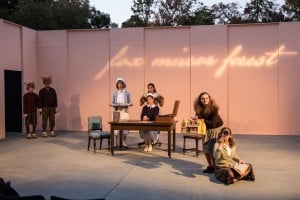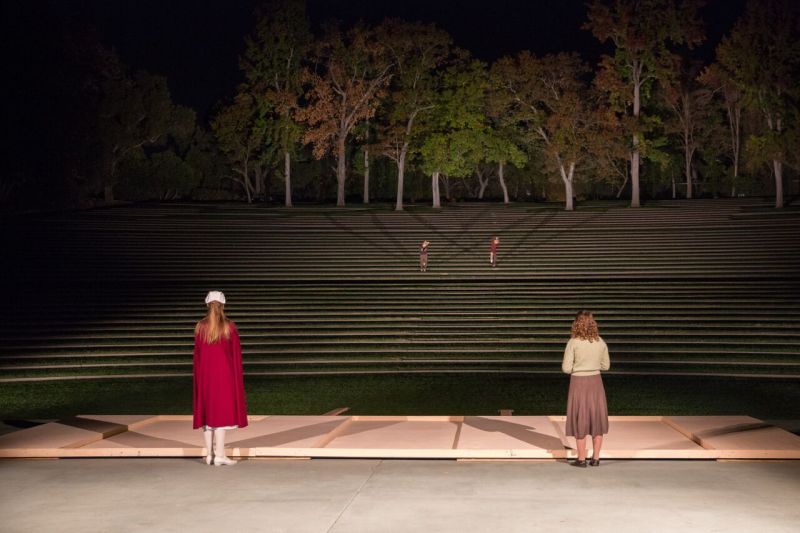The magnetism of “Fox Mirror Forest” is felt immediately upon entering Frost Amphitheater. After winding their way down a narrow path at dusk, audience members crest a small hill separating the world of the theater and the parking lot. Below them, rows of seats face a 20-foot box stage — the vastness of the amphitheater rising up behind it.

It’s immersive and the narrative immediately hooks the audience. “Fox Mirror Forest,” written by Rebecca Ormiston and directed by Rebecca Chaleff, is a graduate student-devised production that is part theater and part modern dance. Inspired by Rosemary Minard’s 1975 collection “Womenfolk and Fairy Tales,” the play captures what it means to live in a world of fantasy without access to reality.
Marked by a convoluted plot, music and audio endeavor to keep everything straight throughout. The performance begins with a podcast explaining that the author, Rosemary Minard, has been accused of encouraging misunderstood young girls to take their own lives. The bodiless voice then announces that “Fox Mirror Forest,” one of Minard’s fairytales, will be performed — upon which two people dressed as foxes, two frizzy-haired librarians, a young girl and a man dressed as a nurse in drag enter. The first 10 minutes of the production is the antithesis of dreary theater.
Upon accepting the world of the fairytale in the next segment of the play, the audience is charmed by the outlandish characters and any initial confusion disintegrates. Despite the heavy subject matter and the fact that the young Rosemary Minard is in a sanatorium, “Fox Mirror Forest” is also a comedy. The play-within-a-play includes a raucous tea party and a librarian with cotton balls in her ears whose sole purpose is to remove words from books. Throughout the performance, however, the humor is interrupted by the entrance of the two foxes, who pause to engage in lengthy modern dances while the actors are frozen onstage. While they are meant to signal young Minard’s fairytale-esque fantasies, the dances detract from the plot and inspire greater confusion.
The final reveal of the performance takes place three-quarters into the show, when the literal third wall of the stage is broken. When the young Minard goes missing, the characters push down the 20-foot back wall of the stage, exposing the amphitheater behind it. The foxes appear hundreds of feet away from the audience from behind the trees and dance for over 10 minutes. While the dance is thoughtfully choreographed and the unveiling of Frost’s expansiveness is stunning, it is drawn-out and loses much of its intended power.
As if embedded plots, comedy, modern dance and music were not enough for a piece of 90-minute theater, “Fox Mirror Forest” also tries its hand at being interactive theater. Meant to “break the fourth wall,” the players periodically make direct references to the audience and attempt to engage them. While a good idea, it seems as though the graduate students who devised the production had a bucket list of things that they wanted to try in their work and attempted, unsuccessfully, to utilize them all.
Contact Olivia Witting at owitting ‘at’ stanford.edu.
